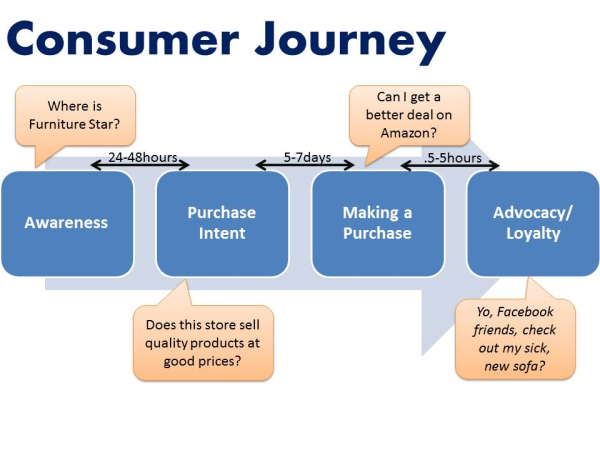Often we look at Google Analytics, Omniture or any other analytics platform to understand what our consumers want. We have to consider, however, that the consumer journey is a lot more complex than a person visiting our site, falling in love with our brand and buying everything in sight.
 Consequentially, we are not going to be able to measure and improve our marketing initiatives until we are able to outline what steps a consumer takes before completing a purchase. Let me use an example. Very recently, a friend of mine (Jake) purchased a new sofa. This was his customer journey:
Consequentially, we are not going to be able to measure and improve our marketing initiatives until we are able to outline what steps a consumer takes before completing a purchase. Let me use an example. Very recently, a friend of mine (Jake) purchased a new sofa. This was his customer journey:
- Sitting on his couch in the evening, he was watching The Office. During commercials, he saw an ad for Furniture Star and realized that he needed a couch especially at such an “amazing price.”
- Next, he got out his iPad and went to the Furniture Star website to learn more about the specials. Unfortunately, the site had a flash component on the homepage and did not perform to Jake’s expectations.
- While researching specials, he went to a number of consumer rating websites to figure out if this was the best store to buy a couch and if this was the best time.
Let’s pause for a minute here. We can already see that consumers like Jake interact with the brand across different devices and mediums. When we plan our marketing efforts, we have to take these nuances into account or we are risking a chance of ruining the experience before the consumer completes a purchase. The website has to work on any device, and consumer rating sites just like our brand sites should tell a positive story about what we do. Let’s continue:
- The next day, Jake is visiting Furniture Star to find the right couch. While at the store, he scans the barcode of a couch using Amazon’s App to check if he can find a better deal.
- After careful examination, Jake finally decided to complete his purchase.
- When he finishes his purchase, he asks a sales professional to take a picture of him on his new sofa using his phone. Just a few minutes later, the picture is on Facebook, and all 1,200 of Jake’s friends comment on his new purchase and feel overly jealous. Then, he ‘Likes’ the Furniture Star Facebook page.
This story, even though somewhat fictional, is very close to reality. Every day, our audience engages with products across multiple devices, using different mediums trying to accomplish various tasks. The job of any marketing analyst is to be able to outline such common consumer journeys and understand how to participate in them. I touch on this in my Universal Analytics post a few weeks ago. In order to accomplish this effectively, you need to break down each step into three components:
- Device – what device is the consumer going to use? Is it going to be a computer, a smartphone, a tablet? How do I ensure that I have the best presence across all of these devices?
- Medium – is the consumer going to visit my Facebook page, my Twitter page, my website, use my smartphone app, or visit a third party such as Yelp to learn more about me?
- Action – what is the consumer trying to accomplish? What constitutes a desired action? Do I want people to Like, to Tweet, to Comment, to Share, to Purchase, or some combination? Different actions are possible across different mediums and on different devices.
Analytics begins with not just measuring the data that is available to you, but with understanding what data you need to collect to make the necessary analysis. The first step is understanding and drawing out your consumer journey. In my next blog post, I will cover in greater detail how Attribution Modeling in Google Analytics can be used to track the consumer journey.
If you have any questions about the consumer journey, don’t hesitate to reach out to me at michael@infotrustllc.com.

